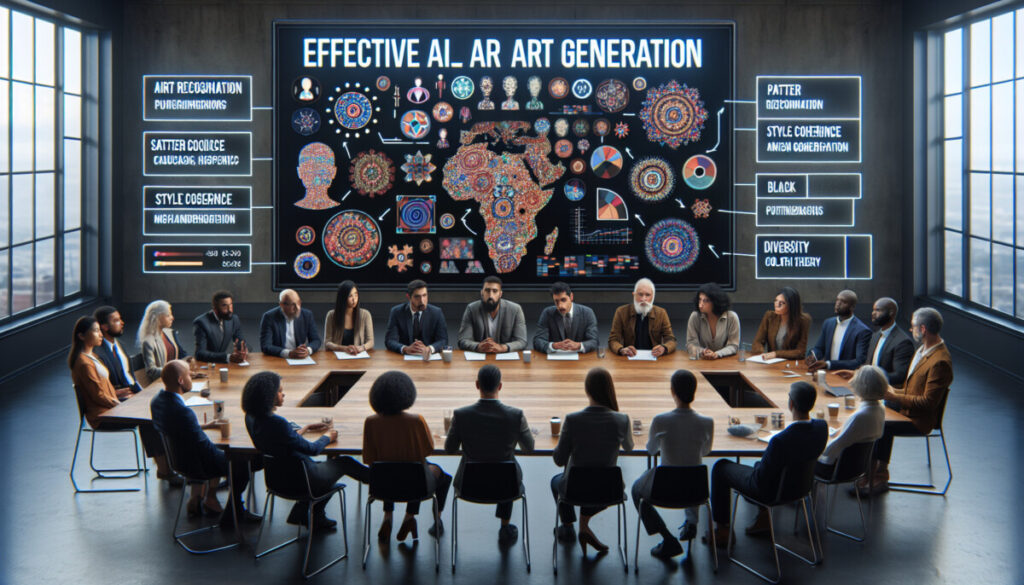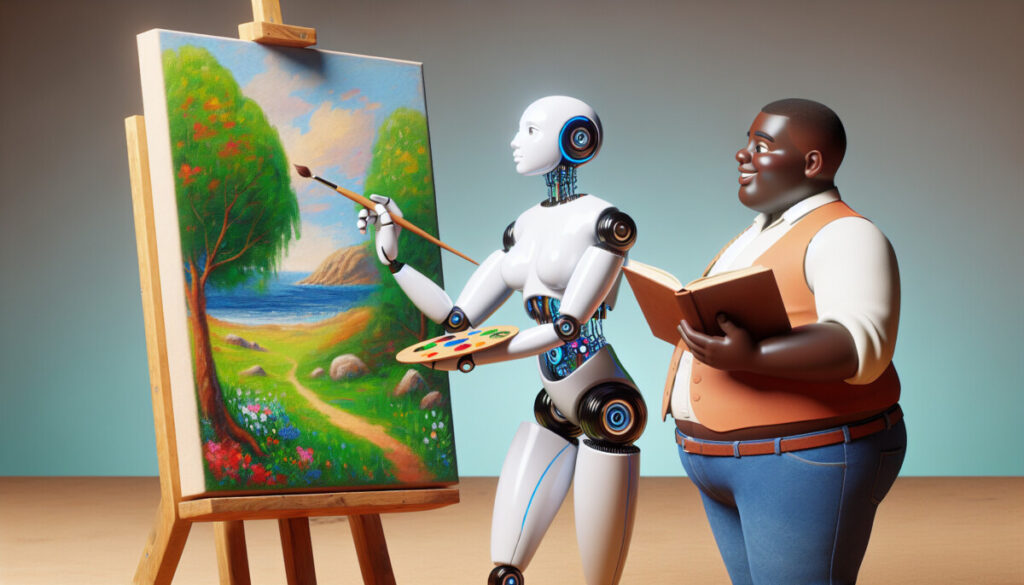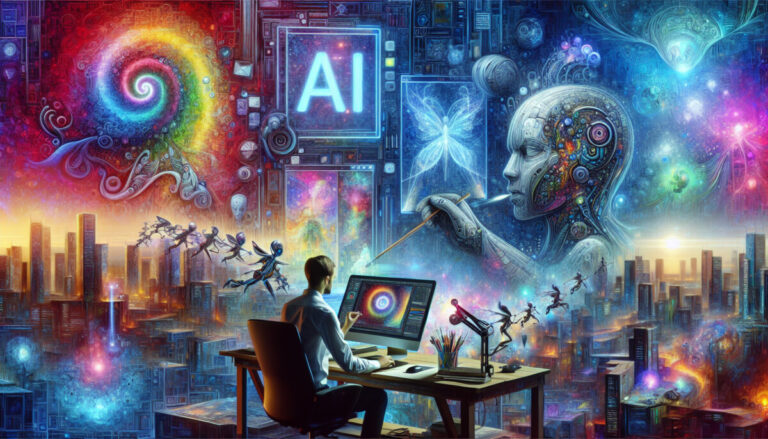AI art generation is revolutionizing the creative industry, allowing artists and enthusiasts to explore new frontiers of creativity. As the popularity of AI-generated artwork continues to grow, mastering the art of AI art generation has become increasingly important.
But how exactly do you get good AI-generated art? How can you make your AI art prompts better? And how can you improve the quality of your AI-generated images? These are just some of the questions that artists and enthusiasts are seeking answers to.
In this blog post, we will reveal the top tips for mastering AI art generation. Whether you’re a seasoned artist or just starting out, these tips will help you unlock the full potential of AI art generation. From crafting effective AI art prompts to choosing the right AI art generator, we’ll cover everything you need to know.
So, if you’re ready to take your AI art to the next level, join us as we explore the world of AI art generation and discover the top tips for creating stunning visuals. Get ready to unleash your creativity and embrace the possibilities of AI art generation. The future of art is here, and it’s waiting for you to explore.
Revolutionizing Art with AI Art Generators
AI art generators have revolutionized the way artists create unique and original artwork. These innovative tools use machine learning algorithms and deep neural networks to generate stunning visuals based on prompts provided by users. By harnessing the power of artificial intelligence, artists can explore new creative possibilities and push the boundaries of traditional art.
Types of AI Art Generators
There are different types of AI art generators available, each with its own unique features and capabilities. Some popular options include:
- Stable Diffusion
- Midjourney
- DALL-E
- HypoArt
- Artbreeder
These generators allow artists to input specific prompts and receive a wide range of generated images that align with their artistic vision. Whether artists are looking to mimic a specific artist’s style, explore different art movements, or depict futuristic concepts, AI art generators can provide endless inspiration.
Benefits of AI Art Generators
One of the key benefits of using AI art generators is the ability to save time and effort in the creative process. Instead of starting from scratch, artists can use AI-generated images as a starting point and build upon them to create their own unique artwork. AI art generators can also serve as a tool for experimentation and exploration, allowing artists to generate initial ideas that can be further developed and refined.
To get good AI-generated art, it is important to provide clear and specific instructions to the AI model. Effective AI art prompts should be detailed, specific, and avoid ambiguity. Including references to other artworks or artists can help narrow down the possibilities and guide the AI model towards the desired aesthetic. It is also recommended to generate multiple options from a prompt and select the favorite or modify it as needed.
To make AI art prompts better, artists can experiment with variations and explore different techniques. Templates for AI art prompts can be used as a starting point and adapted to explore different variations. Artists can also reverse engineer real images, use CLIP Interrogator to generate text prompts based on image content, or fine-tune generation settings to achieve desired results. The key is to continuously iterate and refine AI art prompts to improve the quality and diversity of the generated artwork.
Improving AI-Generated Images
In terms of improving AI-generated images, artists can explore different styles and techniques offered by AI art generators. They can experiment with style transfer and image synthesis to create unique compositions. Artists can also adjust parameters such as colors, filters, and sizes to customize the generated images according to their preferences. The more artists practice generating images based on their ideas, the better their AI art skills will become.
Using an AI Art Generator
Using an AI art generator is relatively straightforward. Artists simply need to input their prompts or desired parameters into the generator and wait for the AI model to generate the images. Some AI art generators may offer additional features or customization options, allowing artists to further refine their artwork. It’s important for artists to familiarize themselves with the specific instructions and functionalities of the chosen AI art generator to make the most out of the tool.

Choosing the Best AI Art Generator
In the world of artificial intelligence (AI), the possibilities for creative expression are expanding rapidly. AI art generators use machine learning algorithms and deep neural networks to generate stunning visual artwork. These AI-powered tools have the ability to automate creative processes and produce images, music, websites, and more. But with so many AI art generators available, how do you choose the best one for your artistic needs?
Let’s start by exploring some of the top AI art generators currently available:
- Stable Diffusion: A popular choice among artists for its ability to create high-quality images with a wide range of styles and themes.
- Midjourney: Another powerful AI art generator that offers advanced features like controlling frame shapes and fixing specific elements like feet and hands.
- DALL-E: Developed by OpenAI, known for its ability to generate highly detailed images based on textual prompts.
- HypoArt and Artbreeder: Worth exploring for their unique features and capabilities.
When evaluating AI art generators, it’s important to consider their features and capabilities. Some generators specialize in specific art styles or themes, while others offer a broader range of options. Look for generators that provide a user-friendly interface and allow you to easily customize and manipulate the generated images. Consider the output quality and resolution, as well as the ability to save and export your artwork in different formats.
To choose the best AI art generator for your specific art style or preference, here are some tips to consider:
- Experiment with different generators and explore their capabilities.
- Generate multiple options from a single prompt and compare the results.
- Look for generators that allow you to fine-tune the output by adjusting parameters like color scheme, level of detail, and realism.
- Consider the level of control you want over the generated images and choose a generator that aligns with your creative vision.
It’s also helpful to research and study examples of AI-generated art to get inspiration and ideas. Join online communities and explore public libraries of AI-generated images to see what others have created. Consider using templates and prompts as a starting point and adapt them to explore different variations. Practice crafting effective AI art prompts by being specific, adding relevant details, and keeping prompts short and precise.
Mastering AI Art Generation: Tips for Effective Use
AI art generators have revolutionized the world of creative expression, offering artists and enthusiasts endless possibilities for creating captivating artworks. To make the most out of AI art generation, it is important to understand and utilize various techniques. In this section, we will explore some tips for effectively using AI art generators.
Selecting the Right Prompts
- Choose specific and detailed prompts to generate desired artworks.
- Include references to other artworks or artists to narrow down possibilities.
- Use clear and concise language to avoid ambiguity.
- Experiment with open-ended phrasing for more creativity.
- Generate multiple options and modify as needed.
Adjusting Parameters and Settings
- Explore different parameters such as color schemes, lighting, and level of detail.
- Experiment with settings to achieve desired aesthetic.
- Adjust color saturation and brightness for vibrant and colorful pieces.
- Fine-tune level of detail and lighting for a realistic look.
- Play around with settings to understand their impact on the final output.
Exploring Different Techniques
- Try unique features like style transfer to combine your input with renowned artist’s style.
- Blend different prompts together for more diverse and complex artworks.
- Experimentation can lead to unexpected and exciting outcomes.
Choosing an AI Art Generator
There are several popular AI art generators available, each with its own unique features and capabilities:
- Stable Diffusion
- Midjourney
- DALL-E
- HypoArt
- Artbreeder
Explore different platforms to find the one that aligns with your artistic vision.
Effectively using AI art generators involves exploring various techniques, selecting the right prompts and input, and adjusting parameters and settings. By following these tips and experimenting with different approaches, you can unlock the full creative potential of AI art generation and create stunning and captivating artworks. So, dive into the world of AI art generation with confidence and curiosity!

Overcoming Challenges in AI Art Generation
When it comes to using AI art generators, artists often face common challenges. These challenges include difficulties in generating realistic faces, hands, and feet, as well as issues with the overall quality of the AI-generated artwork. However, there are strategies and tips that can help artists overcome these challenges and create stunning AI-generated art.
Challenges in AI Art Generation
Generating Realistic Faces
One of the main challenges in AI art generation is the ability to generate realistic faces. AI art generators use machine learning algorithms and deep neural networks to create images, but achieving realistic facial features can be a complex task. To address this challenge, artists can:
- Provide detailed prompts that include references to real faces or specific facial features.
- Give clear instructions and references to help the AI model understand the desired outcome.
Generating Realistic Hands and Feet
Another challenge is generating realistic hands and feet. These body parts can be particularly challenging for AI models to recreate accurately. Artists can overcome this challenge by:
- Using reference images for hands and feet in different poses and angles.
- Providing specific details in their prompts to guide the AI model.
Improving Overall Quality
Improving the overall quality of AI-generated artwork is another important aspect. Artists can enhance the quality by:
- Experimenting with different AI models and algorithms to find the right fit for their vision.
- Fine-tuning generation settings and training their own AI image models for better diversity and quality.

Enhancing AI-Generated Artwork
AI-generated artwork has gained significant popularity in recent years, with advancements in technology allowing for impressive creations. However, there are techniques and tools that can be used to enhance and refine AI-generated artwork, adding that extra touch of creativity and uniqueness.
Explore Different Techniques
One way to enhance AI-generated artwork is by exploring different techniques:
- Experiment with style transfer, which involves applying the style of a particular artist or art movement to the AI-generated image. This technique can give the artwork a distinct aesthetic and make it resemble the works of renowned artists.
Use Additional Software or Tools
Artists can use additional software or tools to add finishing touches to AI-generated artwork:
- Utilize photo editing software to adjust the lighting, colors, and composition of the image. This allows artists to have more control over the final result and tailor it to their artistic vision.
Add Personal Touches
To make AI-generated artwork truly unique, it’s important to add personal touches:
- Incorporate your own artistic style and preferences into the AI-generated image. Experiment with different prompts and instructions to guide the AI model in creating something that aligns with your artistic vision.
- Add personal elements to the AI-generated artwork by including references to your own work or inspirations. This could be a particular color palette, a recurring theme, or a signature style. By infusing your own creativity into the AI-generated artwork, you can ensure that it reflects your unique artistic voice.
Artificial Intelligence in the World of Art
Artificial intelligence (AI) has revolutionized various industries, including the world of art. AI art generators, powered by machine learning algorithms and deep neural networks, have the ability to create unique and original artwork.
Ethical Implications of AI Art Generation
While AI-generated art offers exciting possibilities, it is important to consider the ethical implications of using such technology.
- Authorship and Ownership: AI art generators raise questions about the originality and ownership of AI-generated artwork. Is the AI the creator, or is it the person who programmed the AI? Should AI-generated artwork be protected by copyright law?
- Plagiarism: AI art generators can produce images that closely resemble existing artwork, leading to accusations of plagiarism. Users must be aware of this risk and ensure that their AI-generated artwork does not infringe on the work of others.
Responsible Use of AI-Generated Artwork
To use AI-generated artwork responsibly, it is important to consider the following:
- Give Credit: If an AI-generated artwork is heavily influenced by a specific artist or artwork, it is important to acknowledge that influence and provide proper attribution.
- Impact on the Art Community: Artists and users of AI art generators should be mindful of the potential impact of their creations on the art community. AI-generated artwork should not be used to undermine or devalue the work of human artists, but rather to complement and enhance the creative landscape.
Ethical considerations play a significant role in the world of AI art generation. It is important to address concerns related to copyright and plagiarism, and to use AI-generated artwork responsibly and respectfully. By being aware of the ethical implications and actively working to mitigate any potential issues, we can ensure that AI art generation remains a positive and innovative force in the art world.

Exploring AI Art Generation Resources and Communities
There is a wealth of online resources, courses, and communities dedicated to AI art generation. These platforms provide artists with the opportunity to learn, collaborate, and explore the possibilities of AI-generated art. Whether you are a beginner or an experienced artist looking to expand your skills, these resources can be invaluable in your artistic journey.
Popular Platforms for AI Art Generation
One popular platform for AI art generation is Hypotenuse AI. They offer a blog that provides insights and tips on AI art prompts, techniques, and tools. Additionally, they have a forum where artists can connect, share their work, and seek feedback from the community. This platform is a great place to learn from experienced artists, get inspired, and stay updated on the latest advancements in AI art generation.
Another valuable resource is Toolify AI. They offer various articles and tutorials on mastering different AI art generators, such as Midjourney and Stable Diffusion. These articles provide essential tips and techniques for navigating the AI art generation process. For example, they discuss controlling frame shapes, challenges with generating specific body parts, and using advanced techniques like GFP-GAN for face fixing. These insights can help artists overcome common hurdles and create more refined and accurate AI-generated art.
Online Communities for AI Art Generation
In addition to dedicated websites, social media groups and forums are excellent places to connect with other artists and learn from their experiences. Platforms like Reddit and Facebook have communities specifically dedicated to AI art generation. These groups provide a space for artists to share their work, ask questions, and receive feedback from a supportive community. Participating in these online communities can foster collaboration, inspire new ideas, and help artists grow their skills.
Exploring Different AI Art Generators
When it comes to AI art generation, it’s important to explore different tools and platforms to find the one that best suits your needs and artistic style. Some popular AI art generators include Stable Diffusion, Midjourney, DALL-E, HypoArt, and Artbreeder. Each of these tools has its unique features and capabilities, allowing artists to experiment and create diverse AI-generated images.
Getting Started with AI Art Generation
To get started with AI art generation, you can begin by selecting an AI art generator that interests you and exploring the resources and communities associated with it. Take the time to learn the basics of AI art generation, such as the use of neural networks and machine learning algorithms. Familiarize yourself with the specific prompts and techniques that each tool offers, and don’t be afraid to experiment and iterate with your ideas.
Remember, AI art generation is a collaborative process between the artist and the AI model. It’s essential to provide clear and specific instructions to the AI model through well-crafted prompts. Effective AI art prompts should be detailed, specific, and provide references if needed. Including references to other artworks or artists can help narrow down the possibilities and guide the AI model towards the desired aesthetic.
Resources and communities dedicated to AI art generation provide a wealth of knowledge and support for artists looking to explore this exciting field. Whether through online platforms, courses, or social media groups, artists can learn, collaborate, and refine their skills in AI-generated art. By leveraging these resources, artists can push the boundaries of their creativity and discover new possibilities in their artistic practice.





